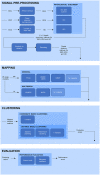Unsupervised Clustering of Individuals Sharing Selective Attentional Focus Using Physiological Synchrony
- PMID: 38235215
- PMCID: PMC10790845
- DOI: 10.3389/fnrgo.2021.750248
Unsupervised Clustering of Individuals Sharing Selective Attentional Focus Using Physiological Synchrony
Abstract
Research on brain signals as indicators of a certain attentional state is moving from laboratory environments to everyday settings. Uncovering the attentional focus of individuals in such settings is challenging because there is usually limited information about real-world events, as well as a lack of data from the real-world context at hand that is correctly labeled with respect to individuals' attentional state. In most approaches, such data is needed to train attention monitoring models. We here investigate whether unsupervised clustering can be combined with physiological synchrony in the electroencephalogram (EEG), electrodermal activity (EDA), and heart rate to automatically identify groups of individuals sharing attentional focus without using knowledge of the sensory stimuli or attentional focus of any of the individuals. We used data from an experiment in which 26 participants listened to an audiobook interspersed with emotional sounds and beeps. Thirteen participants were instructed to focus on the narrative of the audiobook and 13 participants were instructed to focus on the interspersed emotional sounds and beeps. We used a broad range of commonly applied dimensionality reduction ordination techniques-further referred to as mappings-in combination with unsupervised clustering algorithms to identify the two groups of individuals sharing attentional focus based on physiological synchrony. Analyses were performed using the three modalities EEG, EDA, and heart rate separately, and using all possible combinations of these modalities. The best unimodal results were obtained when applying clustering algorithms on physiological synchrony data in EEG, yielding a maximum clustering accuracy of 85%. Even though the use of EDA or heart rate by itself did not lead to accuracies significantly higher than chance level, combining EEG with these measures in a multimodal approach generally resulted in higher classification accuracies than when using only EEG. Additionally, classification results of multimodal data were found to be more consistent across algorithms than unimodal data, making algorithm choice less important. Our finding that unsupervised classification into attentional groups is possible is important to support studies on attentional engagement in everyday settings.
Keywords: EEG; electrodermal activity; heart rate; inter-subject correlation; physiological synchrony; unsupervised clustering; unsupervised learning.
Copyright © 2022 Stuldreher, Merasli, Thammasan, van Erp and Brouwer.
Conflict of interest statement
The authors declare that the research was conducted in the absence of any commercial or financial relationships that could be construed as a potential conflict of interest.
Figures



Similar articles
-
Physiological synchrony in EEG, electrodermal activity and heart rate reflects shared selective auditory attention.J Neural Eng. 2020 Aug 12;17(4):046028. doi: 10.1088/1741-2552/aba87d. J Neural Eng. 2020. PMID: 32698177
-
Physiological Synchrony in EEG, Electrodermal Activity and Heart Rate Detects Attentionally Relevant Events in Time.Front Neurosci. 2020 Dec 3;14:575521. doi: 10.3389/fnins.2020.575521. eCollection 2020. Front Neurosci. 2020. PMID: 33343277 Free PMC article.
-
Physiological synchrony in electrodermal activity predicts decreased vigilant attention induced by sleep deprivation.Front Neuroergon. 2023 Jun 29;4:1199347. doi: 10.3389/fnrgo.2023.1199347. eCollection 2023. Front Neuroergon. 2023. PMID: 38234480 Free PMC article.
-
Multimodal wrist-worn devices for seizure detection and advancing research: Focus on the Empatica wristbands.Epilepsy Res. 2019 Jul;153:79-82. doi: 10.1016/j.eplepsyres.2019.02.007. Epub 2019 Feb 27. Epilepsy Res. 2019. PMID: 30846346 Review.
-
Behavioural modification interventions for medically unexplained symptoms in primary care: systematic reviews and economic evaluation.Health Technol Assess. 2020 Sep;24(46):1-490. doi: 10.3310/hta24460. Health Technol Assess. 2020. PMID: 32975190 Free PMC article.
Cited by
-
Cooperation objective evaluation in aviation: validation and comparison of two novel approaches in simulated environment.Front Neuroinform. 2024 Sep 17;18:1409322. doi: 10.3389/fninf.2024.1409322. eCollection 2024. Front Neuroinform. 2024. PMID: 39376698 Free PMC article.
-
Intersubject correlation as a predictor of attention: a systematic review.BMC Psychol. 2025 May 22;13(1):546. doi: 10.1186/s40359-025-02879-7. BMC Psychol. 2025. PMID: 40405228 Free PMC article.
-
Ear-EEG Measures of Auditory Attention to Continuous Speech.Front Neurosci. 2022 May 3;16:869426. doi: 10.3389/fnins.2022.869426. eCollection 2022. Front Neurosci. 2022. PMID: 35592265 Free PMC article.
-
Self-Supervised Contrastive Learning for Medical Time Series: A Systematic Review.Sensors (Basel). 2023 Apr 23;23(9):4221. doi: 10.3390/s23094221. Sensors (Basel). 2023. PMID: 37177423 Free PMC article.
References
-
- Abiri R., Borhani S., Jiang Y., Zhao X. (2019). Decoding attentional state to faces and scenes using EEG brainwaves. Complexity 2019, 6862031. 10.1155/2019/6862031 - DOI
-
- Bauckhage C. (2015). Numpy/Scipy Recipes for Data Science: k-Medoids Clustering. Technical Report, University of Bonn.
LinkOut - more resources
Full Text Sources

